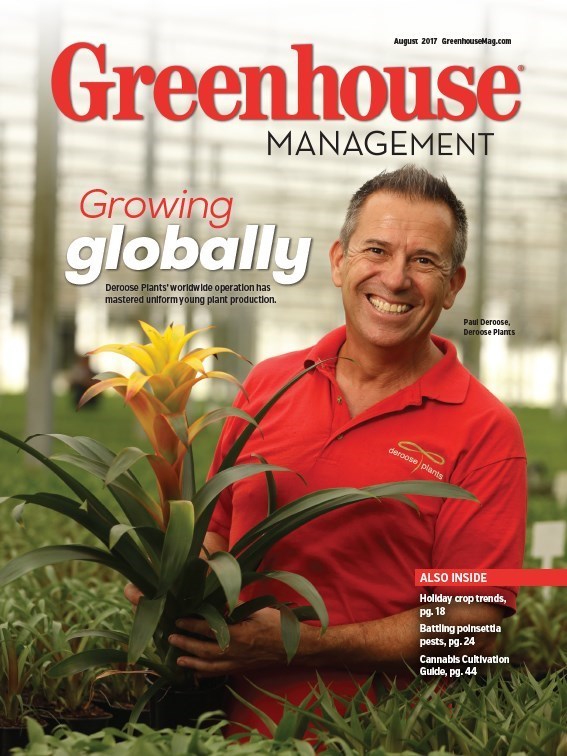
Traditional agriculture has proven that greenhouses have a lower cost of production and are more sustainable than indoor production. Maybe that’s why 41 percent of cultivators who don’t currently grow in a greenhouse say they will add greenhouse facilities in the next two years, according to Cannabis Business Times’ 2016 “State of the Industry” report, which can be found at bit.ly/2vFvvnr
A properly sealed and constructed greenhouse with state-of-the-art environmental controls also protects against pest and disease infection more effectively than other methods, helping to eliminate the need for pesticides. (A properly constructed greenhouse means cement floors, sealed environments with filtered and sterilized incoming airflow combined with slight positive pressure to the greenhouse, and with proper decontamination and prevention practices, water sterilization capabilities and strict protocols regarding all materials that enter the greenhouse.)
Why is this important? Because the industry has a significant problem with product failing test results due to pesticide use. Cannabis testing and analysis firm Steep Hill Labs reported that 84 percent of the California cannabis and 62 percent of the Washington state cannabis that the firm tested failed testing. Much of the failure was caused by Myclobutanil, used for prevention and control of mildew outbreaks.
Moving to the greenhouse
There are many factors to consider when transitioning to a greenhouse. What follows are just a few things that can ultimately dictate your success or failure. They range from the simplest processes adopted from sustainable organic/biodynamic cultivation practices, such as planting insect-deterring plants around the greenhouse combined with plants that attract predator insects, to using sophisticated heating and dehumidification equipment.
Three key factors to consider include:
1. Capacity
If you’re in the planning stages of building an indoor facility with the intent of transitioning to a greenhouse, you must consider designing a facility that can feed the greenhouse with an abundant supply of vegetated 18-inch to 24-inch plants. If you design the indoor facility to produce only tissue cultures/clones, vegetative plants and mother plants, the greenhouse can then be filled only with flowering plants. This would ensure maximum efficiency is achieved while minimizing environmental exposure to the plants during early stages of growth. Starting the flowering cycle “clean” means the plants will then only be susceptible to infection for a minimal amount of time, eight to 10 weeks.

2. Greenhouse coverings
The composition of your greenhouse covering is one of the most important decisions you will make. Greenhouse covering manufacturers offer several types of coverings, all with varying ultraviolet (UV) inhibitors rated by percentage. UV inhibitors are important for minimizing the degradation of the greenhouse's coverings and their contents. They also assist in controlling thermal transmission and excessive leaf surface/plant canopy temperatures, as excessive radiant or ambient temperatures are detrimental to healthy, productive photosynthesis, which stops at temperatures exceeding 75°F.
But cannabis plants use UV to produce THC and possibly other cannabinoids and terpenoids. Using a greenhouse covering with maximum UV inhibitors would stifle THC production and be counterproductive. Based on your geographic location and climate, you must decide whether to use UV inhibitors to control temperatures or to reduce the amount of UV inhibitors to maximize THC production.
Consulting with your greenhouse manufacturer and determining exactly which covering is best for your needs and your location is a make-or-break decision.
To compensate for a lack of UV inhibitors, many growers choose retractable shade cloth, which is also rated in percentages, meaning a 10 percent shade cloth would prevent 10 percent light transmission to the plants.
Many growers are familiar with blackout covering or shades, long used for light deprivation in greenhouses. Professional greenhouse growers employ both shade cloth to prevent excessive surface temperatures and reflective cloth to minimize light and heat transmission into the greenhouse. You can adopt the same method in the winter, as well. When sundown approaches, the shades and reflective shade both can be drawn over the plants as supplemental lighting turns on to trap heat in the growing environment and help minimize heating costs overnight.
3. Heating and cooling
A feasibility study can help you determine how a location’s climate may impact your heating and cooling costs. For example, a greenhouse in a location that’s too cold may produce no profit during the winter months because of heating costs. The same could be said for locating your greenhouse in certain areas of Nevada, Arizona or California desert regions, where summer temperatures must be managed properly and efficiently. Cooling a greenhouse in a desert can cost a lot. In addition, desert temperatures are counterproductive to healthy growth and cause rapid transpiration and elevated humidity levels, which ultimately result in mold or mildew outbreaks. Perhaps most importantly, excessive heat causes plant stress.
If planned and managed properly, greenhouses can offer cultivators significant cost and quality advantages. When considering a move to greenhouses, take the time to understand all the potential variables to ensure you're maximizing the value of greenhouse production.

Explore the August 2017 Issue
Check out more from this issue and find your next story to read.
Latest from Greenhouse Management
- Chilli thrips (Scirtothrips dorsalis)
- GS1 US Celebrates 50-Year Barcode 'Scanniversary' and Heralds Next-Generation Barcode to Support Modern Commerce
- University of Florida offers Greenhouse Training Online program on irrigation water
- Flower trends in full bloom
- ‘Part of our story’
- Dramm introduces new hose, sprinkler attachments for home gardeners, nurseries
- Nominate an outstanding leader
- Profile Products hires sales and business development manager for Europe and Asia





